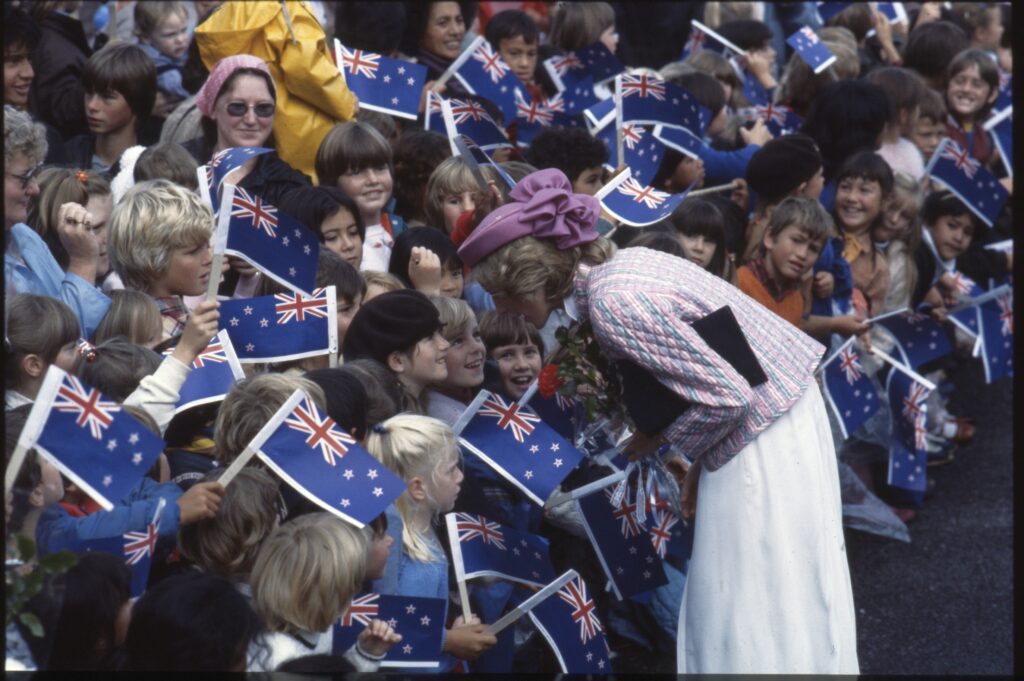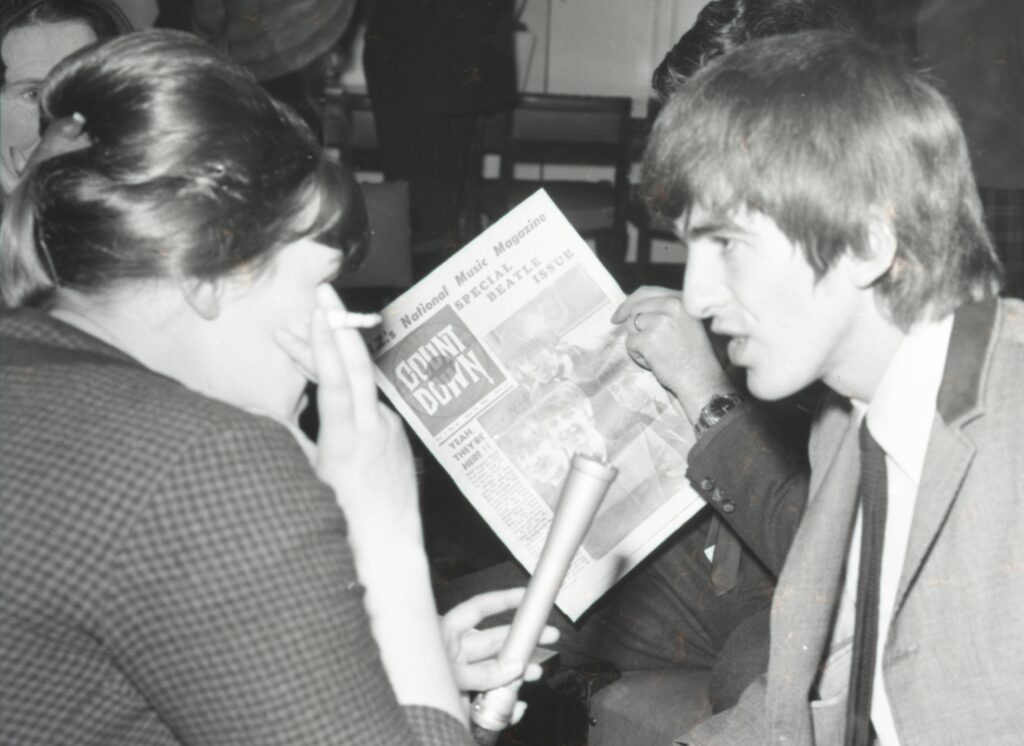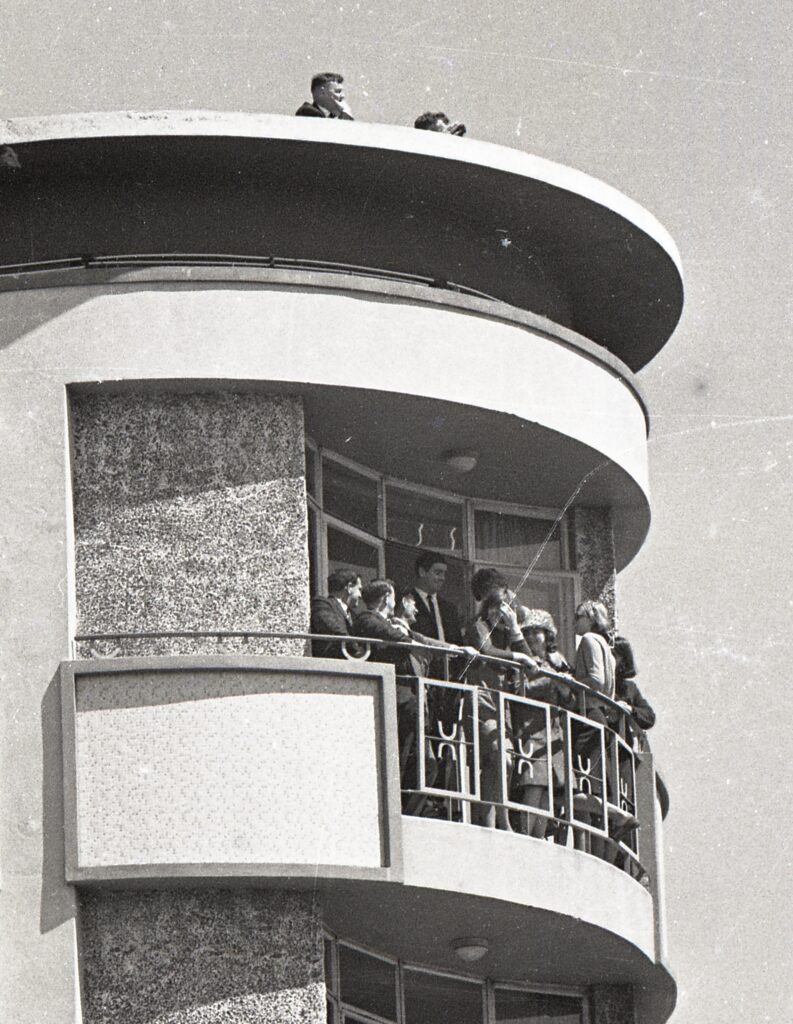This articles was written by Evan Greensides for Te Manawa Museum of Art, Science and Heritage as part of the Peter Bush Collection Project in 2024. All images used with permission of the Bush Family. Please contact Te Manawa for the use and re-use of images.

Spending part of my free time as an amateur photographer, combined with a decade and a half in the GLAMR sector, I have slowly developed an eye for details beyond the immediate subject of an image. Often overlooked by human eyes, especially if the primary subject is famous, rare, or controversial, peering into the details and asking inquiring questions can pique interest, add context, and result in viewers thinking deeper about the content within the image. This article aims to delve deeply into several aspects of images using select photographs taken by Peter Bush – to surface unseen details, enriching the historical content of famous images.
Thoughts of a Young Mind
Imagine the thrill of meeting a famous person, especially when you are a child. It is not every day you get to shake hands with a famous person or your personal hero at a big event. These moments can be unforgettable, sparking inspiration and excitement in young hearts. Most of the momentous events Peter Bush attended, including royal tours, Commonwealth Games and All Blacks matches, included children in attendance.
According to Bandura’s social learning theory, young people learn behaviours, attitudes, and values by observing and imitating others, especially those they respect and admire, such as their parents or famous individuals. It may bring about a series of questions for the viewer about the young person in the image:
- What were they told, by parents, teachers, friends, about the famous individual before meeting them?
- Did their expectations live up to reality?
- Did the meeting have a profound impact on their values or traits?
- Did they closely bond with their parents, who may emulate the famous person, over the encounter?

The Metareference
A metareference is a phenomenon where an element within a piece of content refers to itself or another element within the same context. This creates a self-referential loop within the visual context, highlighting the interconnectedness of the subjects within the scene.
“You say you want a Revolution”? Well, that revolution landed in Wellington onboard a TEAL flight on Sunday, 21 June 1964 in the form of four young musicians from Liverpool. Seven days of pandemonium ensued as New Zealanders young and old flocked to hear or just catch a glimpse of The Beatles. Amongst the seven thousand screaming fans, Peter Bush captured iconic photographs of the Fab Four stepping off the plane (giant stuffed Kiwi and plastic tiki around their necks), taxied past fans at the airport wire in the back of a Holden utility vehicle, and on to the first concert at Wellington Town Hall.
After the first concert, the band split up to go off with individual reporters to answer questions. Amongst the backroom haze, George Harrison sat down to light up a cigarette with a reporter from an unknown publisher. Positioned at the perfect angle, Peter captured this metareference image – George Harrison during an interview, with the added layer of a man reading a copy of Count Down featuring a front-page article about The Beatles tour of New Zealand, complete with picture of George Harrison and bandmates.

Poles Apart
In 1968, U.S. President Lyndon B. Johnson visited New Zealand as part of his global tour to strengthen alliances and discuss the Vietnam War. His visit included a stop in Wellington, where he met with Prime Minister Keith Holyoake. Johnson received a warm welcome from most of the crowd as protests against New Zealand’s involvement in the Vietnam War had not peaked yet. His presence sparked significant media coverage and public debate. The visit highlighted New Zealand’s strategic importance and the complexities of international relations during a turbulent period.
During his time in Wellington, Johnson was keen to shake hands with as many members of the well-wishing crowd as possible, much to the consternation of his Secret Service security detail. Considering the assassination of his predecessor 3 years earlier, it is no surprise that Johnson’s bodyguards had their misgivings about the overwhelming crowds and relaxed attitude of New Zealand police officers.
Eagle-eyed Peter Bush, always on the hunt for a good photo, spotted Secret Service agents on the roof of an apartment building. The unaware resident crowds on balconies contrasts sharply with the on-alert agents on the roof above peering through large binoculars for threats in the crowded street below.

Here and Gone
On 10 April 1968, the worst storm in local memory devastated the Wellington region, causing the interisland ferry, Wahine, to founder in Wellington Harbour. Running aground near Steeple Rock in the suburb of Seatoun, fifty-one lives were lost on that fateful day. In his autobiographical book, Peter Bush: A Life in Focus (pages 232-233), Peter states that on that April day he was working for the Truth at the Wellington Courthouse, when:
In the middle of proceedings [Judge] Scully sent a court official over to the media area to tell us to approach the bench. “I don’t know whether you gentlemen are aware of this,” he said, “but the Wahine’s sinking out in the harbour.” We practically ran out of his courtroom.
Trusty camera in hand, Peter ran down to Seatoun Beach to join a crowd of onlookers, and to snap the only known colour photographs in existence of the Wahine disaster. He then moved along to old Fort Dorset and captured the three jagged rocks of Point Dorset in front of Wahine. One of these images shows a concrete gun emplacement on top of the last piece of land before entering the sea.

Interest piqued, I searched for the old Fort Dorset plans, helpfully uploaded and made available online by the NZ Coastal Defences website. Unfortunately, no such structure is visible on any of the plans. Paradoxically, a 1962 oblique aerial photograph points out all of Fort Dorset’s structures – all except the lonely outpost at the tip of Fort Dorset. Another oblique aerial photograph from 1959 clearly shows the structure near the iconic razor-tooth rocks, but still with no label. Alas, current satellite photographs show a bare, flat outcropping where the structure once stood, dismantled around 1970 when outlying buildings of Fort Dorset were demolished.
When we look closely at images, we can discover further details in photographs we once took for granted or thought we fully understood. Peter Bush’s unique photographic skills allowed him to capture remarkable events in our nation’s history, as well as the often overlooked, everyday moments that intersected with these events. There is no doubt that the Peter Bush Collection will reshape long-held views and offer up added content and context the deeper we delve into its depths.
